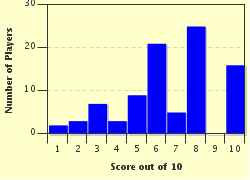Quiz Answer Key and Fun Facts
1. Smoke rises vertically, no movement of leaves or flags
2. Smoke slants slightly with wind, no movement of leaves or flags
3. Wind is felt on the skin; leaves move slightly, and flags flutter
4. Leaves and twigs move steadily, light flags can be seen extended
5. Dirt and papers blow in the wind; small tree branches move
6. Large branches move, umbrellas are hard to control
7. Sizable trees moving, people have difficulty walking against the wind
8. Twigs break from trees, cars swerve on road, people experience serious difficulty walking
9. Trees are uprooted, buildings experience structural damage
10. Widespread damage to trees and buildings, sizable unsecured objects flying around
Source: Author
looney_tunes
This quiz was reviewed by FunTrivia editor
NatalieW before going online.
Any errors found in FunTrivia content are routinely corrected through our feedback system.

